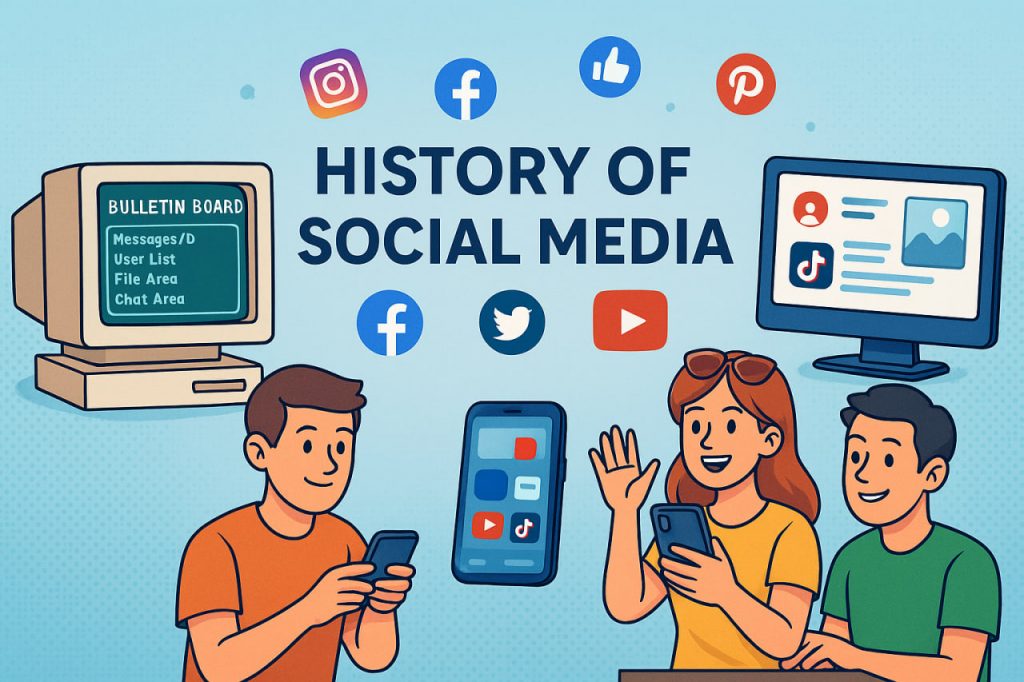The origins of social media trace back to the 1970s and 1980s, long before Facebook and Instagram. Early online communities formed through bulletin board systems (BBS) and Usenet, where users could post messages, share files, and discuss topics via dial-up connections. These platforms were text-based and often limited to local users, but they laid the groundwork for online interaction.
By the 1990s, services like AOL, CompuServe, and IRC (Internet Relay Chat) expanded digital communication, introducing chat rooms, personal profiles, and instant messaging — all core components of modern social networks.
Rise of the First Social Networks (2000–2005)
The early 2000s brought the first true “social media” platforms:
- SixDegrees (1997–2001): One of the earliest networks that allowed users to create profiles and connect with friends.
- Friendster (2002) and Hi5: Helped pioneer the idea of a social graph — a map of user connections.
- MySpace (2003): Became the first global social media hit, letting users customize profile pages, share music, and build communities.
- LinkedIn (2003): Focused on professional networking, and remains a leading business platform today.
These sites introduced features we now consider standard: friend lists, photo sharing, status updates, and user-generated content.
The Facebook Era and Global Expansion (2004–2012)
In 2004, Facebook was launched for college students and soon opened to the public, quickly surpassing competitors. Its simple interface, real-name policy, and network-based structure revolutionized online identity and interaction.
Soon after:
- Twitter (2006) enabled short-form, real-time communication.
- YouTube (2005) transformed video sharing and introduced the concept of viral content.
- Instagram (2010) and Pinterest (2010) catered to visual storytelling and curation.
- WhatsApp (2009) changed private messaging across the world.
Smartphone adoption accelerated social media growth, allowing users to stay connected anytime, anywhere.
Social Media Today: Influence and Innovation
Modern social networks are deeply integrated into daily life, with billions of users on platforms like:
- Facebook, Instagram, TikTok, Snapchat, X (formerly Twitter), and Reddit.
- These networks drive news, commerce, entertainment, and even politics.
- Social media influencers, brand pages, livestreams, and short-form content dominate attention online.
At the same time, new concerns have emerged:
- Privacy and data misuse
- Algorithmic echo chambers
- Mental health impacts
- Misinformation and manipulation
The Future of Social Media
Social media continues to evolve:
- AI and personalization are shaping user experience.
- Decentralized networks like Mastodon aim to give users more control.
- Virtual and augmented reality (e.g., Meta’s metaverse) promise immersive social environments.
- Digital identities, avatars, and blockchain may redefine ownership and presence online.
From modest text exchanges to immersive global platforms, social media has become one of the most transformative forces of the 21st century.
Glossary
- BBS (Bulletin Board System) — an early digital forum where users could leave messages and share files.
- Social graph — a representation of connections and relationships between users online.
- Viral content — media that spreads rapidly and widely across the internet.
- Algorithm — a programmed set of rules that determines what content users see.
- Decentralized network — a system where no single company controls the platform or user data.


